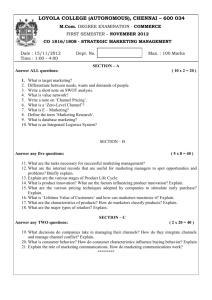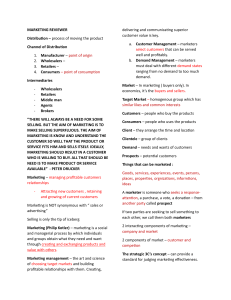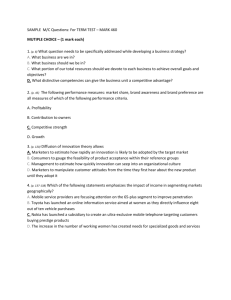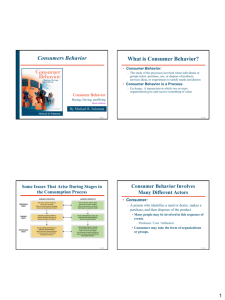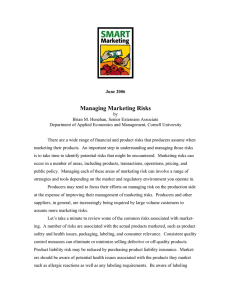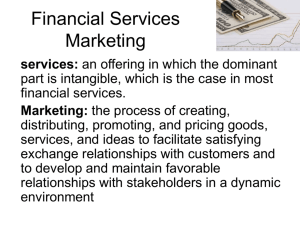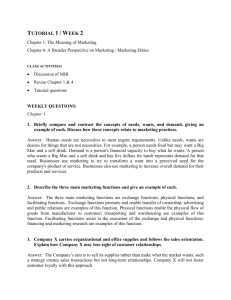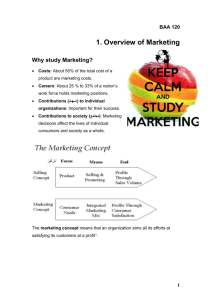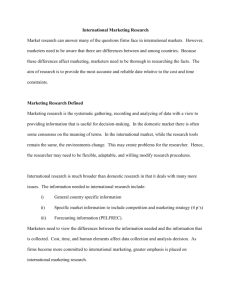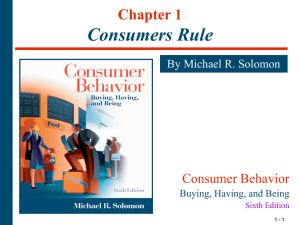Chapter 8 – Producing and Marketing Goods and Services
advertisement
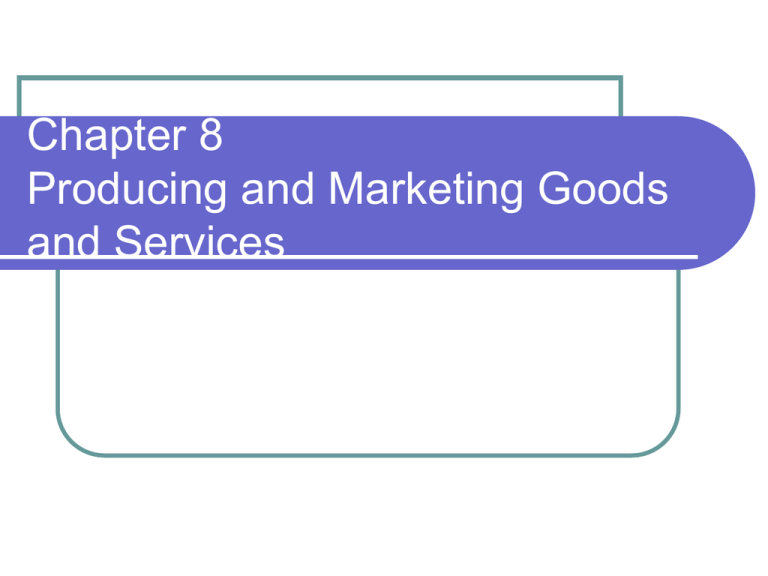
Chapter 8 Producing and Marketing Goods and Services Marketing Marketing – all of the activities used to insure the effective exchange of goods and services between businesses and consumers. Marketers – the people and businesses who complete marketing activities. Marketers use research: 1. to determine the wants and needs of consumers 2. to test new ideas with consumers Marketers select the product name, design packaging and begin to develop advertising. Marketers decide where the product will be sold, how to get the products from the place they are produced to the selling location. Marketers help set price and decide what forms of payment will be accepted. Marketing functions Marketing functions – groups of marketing activities that must be completed in order for an exchange to occur: 1. product/service planning – assists in design and development. 2. purchasing – identifies and obtains the products needed. 3. financing – have finances and credit available to support purchase and sale of products 4. distribution – getting the product to the customers 5. pricing – setting prices and payment methods. 6. risk management – provides security and safety for products and people, reduces risks 7. marketing information management – obtains or organizes information to make marketing decisions. 8. promotion – involves communicating with consumers. Impact of Marketing on Your Life – page 104 Marketing increases our standard of living by helping businesses understand our needs so they can produce the products and services we want. MARKET CONCEPT -- The philosophy of business -- most successful businesses think of the consumer as they produce and market products and services. Consider needs of customers when planning, pricing, distributing, and promoting a product or service. To be successful, businesses must: 1. identify the customers they want to serve 2. develop a product to satisfy the customers and complete necessary marketing activities. 3. complete all activities at a profit A Marketing Strategy 2 step process for successfully planning and marketing products and services 1. identify a target market 2. develop a marketing mix marketing mix: a combination of marketing elements designed to meet the needs of the target market 4 Ps of Marketing Product – anything offered to the target market to satisfy needs Place – Distribution – includes locations where products are sold and ways they are made available. Price – what customers pay and method of payment Promotion – methods used to communicate information to customers to encourage purchase and increase their satisfaction Product Development Steps – page 106 1. Develop a new product idea 2. test the idea with prospective customers 3. construct a product model and test it 4. design production and marketing procedures 5. develop budgets and forecast sales 6. prepare for manufacturing Planning, Developing and Testing New Goods and Services Developing products and services that consumers want Buying Motives – reasons for making a purchase Can be rational based on facts or logic Can be emotional, based on feelings and attitudes Planning Distribution Channels How do we get product to customers? Channel of Distribution – path that a product travels from producer to consumer Direct channel of distribution – process through which goods are bought by the consumer directly from the producer Indirect channel of distribution – process through which goods move through one or more middle firms between producer and the consumer Wholesaler -- middle firm that assists with distribution activities between businesses Retailer – a business firm that sells directly to the consumer Effective Distribution Characteristics (pages 109-110) 1. Differences in Quantity 2. Differences in Assortment 3. Differences in Location 4. Differences in Time THE ROLE OF PRICING (page 110) Price – what we pay for products and services Goals and Objectives of Pricing GOALS 1. cover cost and make a profit 2. want a prices that consumers view as a good value 3. price that won’t put them at a competitive disadvantage OBJECTIVES 1. maximize profits 2. increase sales 3. maintain an image Factors that influence prices 1. 2. 3. 4. the quantity purchased the level of customer service offered product special handling or if its fragile No. of businesses in channel of distribution 5. amount of advertising needed Promotion for Successful Marketing Promotion -- the marketing tool businesses use to communicate with consumers to persuade them to purchase its products The Role of Promotion Attract new customers Inform customers Persuade customers Reinforce the decisions Remind them how it meets their needs Selecting Promotional Methods and Media Media Advertising – information paid by company to reach large audiences Sales Promotions – coupons, contests, and free samples Publicity – appears in media, not paid for by company Personal Selling – direct, personnel communication between salesperson and customer Steps in the Selling Process Preapproach Approach Demonstration Questioning Close Follow-Up Figure 8-4 page 111
